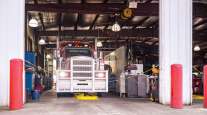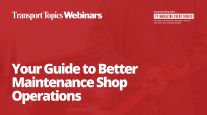Fleets Find Challenges in Rising Maintenance Costs, Parts Shortages
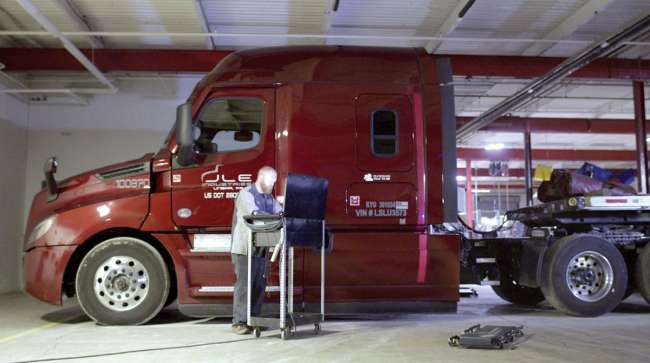
[Stay on top of transportation news: Get TTNews in your inbox.]
With a laundry list of hurdles — inflation; fuel, equipment and labor costs; and the supply chain — facing many trucking companies, the focus on preventive maintenance becomes clearer as fleets are adding alternative suppliers and providers, and stockpiling inventory to help control costs and reduce downtime.
“Shop door rates have continued to climb aggressively. Parts pricing has also continued to climb across the board,” said Kirk Altrichter, executive vice president of fleet services for Kenan Advantage.
Maintenance costs were down in 2020 due to COVID-19’s impact but started climbing in 2021 and have only gathered steam through the second quarter of 2021 to today, he said.
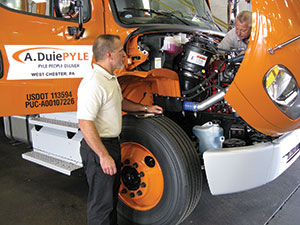
Carrano (left) discusses maintenance with a tech. To help control costs, A. Duie Pyle evaluates PM inspection schedules of all power units to maximize the time between maintenance work.
(A. Duie Pyle)
Tim Moore, vice president of TMcare Operations at FleetNet America, said FleetNet tracked a 9% increase in the cost to repair in 2021 from 2020 and a 20.4% increase year-to-date in 2022 from 2020.
“In the short term, I don’t know that it will get any better until there is pressure relieved off of inflation and the supply chain gets back to normal,” he said.
At the same time, many fleets are keeping equipment longer due to manufacturer delays, which can increase maintenance needs. “Of the total order that we intended on placing, we’re only going to get 57% of that order on the power units and 66% of the trailers,” said Dan Carrano, vice president of fleet maintenance for A. Duie Pyle.
To help control costs, A. Duie Pyle evaluates PM inspection schedules of all power units to maximize the time between PMs and lessens PM intervals for some duty cycles. “All the PMs are on a time or mileage basis, whatever comes first,” Carrano said.
JLE Industries, a flatbed carrier based in Homestead, Pa., is reducing intervals on PMs, company CEO Evan Pohaski said. “That is something we can control. We want to get more hands-on, detailed visuals of the equipment,” he said, adding that lights, brakes and small components can keep a truck down. “We are trying to get out in front of these small, ankle-biter problems.”
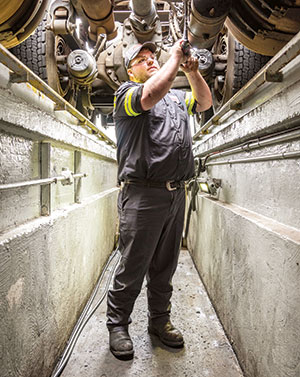
An Averitt maintenance tech. Maintenance costs were down in 2020 due to COVID-19’s impact but have risen since 2021. (Averitt Experss)
Averitt Express uses a PM scheduler to help maintain PM compliance. “We also perform yearly shop audits and monitor key performance indicators on a weekly basis,” said Doug Lloyd, director of maintenance for the fleet.
Controlling idle time can help prevent breakdowns related to after-treatment systems and emissions. “Drivers still idle despite having [auxiliary power units],” Pohaski said, adding that the fleet is coaching drivers to help avoid what will be a very costly repair.
JLE Industries is also focusing on the root cause of trailer tire issues the fleet is experiencing. “We are putting a task force to go visit 20 of our top 100 customers and look at their facilities to see if they are having trouble keeping up with the cleanliness of ingress and egress,” Pohaski said.
Moore said pre- and post-trip inspections have always been essential to prevent delays and remain an important tool to avoid breakdowns. Unfortunately, a lot of drivers don’t do them as they should.
Prioritizing Repairs
Given labor and parts challenges, fleets are prioritizing repairs. Carrano said safety-related repairs are done first, repairs related to reliability are second and everything else, such as comfort or convenience items, is third. “We also prioritize specialty equipment — liftgate versus non-liftgate or tandem axles used for pickup and delivery during the day and linehaul at night,” he said.
Altrichter said Kenan Advantage evaluates the time needed for repairs. “If we can get several pieces of equipment repaired and back on the road in the time it would take to fix one piece of equipment, we may let the one piece of equipment sit,” he said.
Averitt Express, which is based in Cookeville, Tenn., and ranks No. 36 on the Transport Topics Top 100 list of the largest for-hire carriers in North America, is prioritizing repairs on a driver wait/loaded basis, Lloyd said.
Maintenance delays are affecting productivity. “One of the things I continually hear about is downtime. Whether it is waiting to get into the shop because of the technician or waiting to get parts, it is taking extra time,” Moore said. “There is an indirect cost of the loss of that revenue of the tractor.”
Pohaski said the average turn time of a repair has gone from two to three days to two to three weeks. Typically, JLE has a 93-94 working truck percentage. “Now it is in the mid-80s. A lot of that has to do with the fact that there is a lot of breakdown activity keeping the trucks down for more time than necessary,” Pohaski said.
JLE has started stocking inventory, and sources parts directly to outside facilities to try to expedite turn times.
A. Duie Pyle has increased its inventory within its centralized parts warehouse. Everything from tires, windshields, wiper motors and belt tensioners can be hard to come by, Carrano said.
“On a regular basis, we probably have 60-80 parts on back order daily. It isn’t the same part. It continually evolves,” he said. “There are thousands of parts, and you can’t stock up on everything. You look at what is hard to source and keep extra of those.”
Averitt Express reduces tractor downtime by having shop leadership locate parts and communicate availabilities across its network. “We are also utilizing remote diagnostics,” Lloyd said.
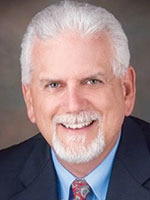
Moore
Basic supply-and-demand principles are driving up costs, and FleetNet has seen anywhere from an 8% to 14% increase in parts pricing, Moore said.
Some are going even higher. Brake drums are up around 47%, Carrano said. “Brake drums are made of pig iron — a low-grade steel — and a big exporter of pig iron is Ukraine,” he said. “Brake drums, brake rotors and brake kits are getting hard to come by because people are stocking up on them because of the war. Those are parts used regularly.”
A. Duie Pyle has outsourced for aftermarket parts, especially for trailer or straight truck body parts. Aluminum extrusion trailer or straight truck parts have been difficult to procure because OEs are prioritizing their assembly lines, Carrano said.
Moore said fleets are increasingly open to new brands. “You’re going to have to be a little flexible on the brands you use, even down to the oil filters. You should never sacrifice quality, but I think fleets have become a lot more flexible, not by choice but by necessity,” he said.
Traditionally A. Duie Pyle, which is based in West Chester, Pa., and ranks No. 69 on the TT100, ran one brand of tires, with a specific make on steer tires, a specific make on drive tires and the same on the trailers.
“Because of the shortage of tires, we’ve had to change tread design on that make of tire and add other brands,” Carrano said. “We’re making changes to other things, including engine oil. Allocation is becoming the new word, and for a while, we were on allocation from the oil manufacturer. We had to source other oils.”
Roadside Repair Challenges
Fuel is among the factors driving increased costs, especially for roadside repairs and towing. “A lot of issues happen outside on the road that require a service call. With fuel up 65% year over year, those service calls are up,” Pohaski said.
The bigger issue is the lack of availability of roadside service. “Evening breakdowns are becoming critical because of the labor shortage,” Carrano said. “People don’t want to work nights or change a tire on the side of the road.”
One of A. Duie Pyle’s drivers recently had a tire issue roadside, but neither the tire provider nor the manufacturer’s 800 number had a technician to send. “Our nearest terminal was 95 miles away, and we had to send a fleet tech 95 miles one way,” Carrano said.
Downtime for drivers stuck roadside creates additional challenges. “If a driver isn’t able to make it to the final destination, you have to route him to a terminal, or if he is near the end of his day and runs out of hours, you have to send a rescue driver out to relieve him,” Carrano said.
Pohaski said JLE is attentive to drivers’ earnings and home time expectations, but it can be tough. “When you have a piece of equipment go down, it is very difficult to reach down into your pocket and stabilize the driver for that period of time or spend three times what we did a few years ago to rent a car so a driver can get home for a particular event that means a lot to them,” he said.
With labor costs increasing, A. Duie Pyle has had to raise hourly wages for technicians. “We have a workforce crisis in this country. There are not enough people working, and we have a 25-year-plus fleet tech shortage. From a maintenance perspective, there aren’t enough techs,” Carrano said.
A clear promotion path that includes training and pay tied to training helps retain technicians, Altrichter said. “However, nothing beats staying in touch with the technicians and giving them a pat on the back and making them feel like a part of the team,” he said.
Want more news? Listen to today's daily briefing above or go here for more info
Creating partnerships with maintenance providers can help fleets get the service they need. “It has to be a mix, especially if you have your own shop network. You still have a need to outsource, and you have to have strong partnerships with your service providers,” Moore said. “It keeps things moving.”
JLE has built up a virtual network or service providers it can route drivers through for work that needs to be done while they’re on the road, Pohaski said.
Altrichter said Kenan Advantage, which is based in North Canton, Ohio, and ranks No. 23 on the TT100, has long-term relationships with its providers. “Although they are not able to always mitigate the cost increase they are receiving, we all understand that this current environment will abate at some point, so we are working together to make the best decisions jointly,” he said.


